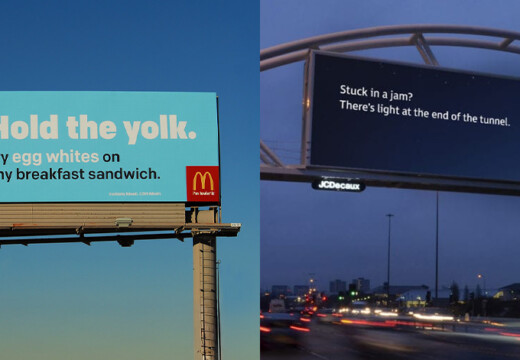Looking to advertise with billboards but unsure whether to go digital or stick with static designs? Here’s a quick breakdown to help you decide:
-
Digital Billboards:
- Monthly Cost: $1,200–$15,000+ (varies by location).
- Setup Costs: $1,000–$5,000 for content creation.
- Best For: Short-term, time-sensitive campaigns with frequent updates.
-
Traditional Billboards:
- Monthly Cost: $750–$14,000.
- Setup Costs: $200–$1,000 for printing and design.
- Best For: Long-term campaigns focused on consistent messaging.
Quick Comparison Table:
| Feature | Digital Billboards | Traditional Billboards |
|---|---|---|
| Monthly Cost | $1,200–$15,000+ | $750–$14,000 |
| Setup Costs | $1,000–$5,000 | $200–$1,000 |
| Maintenance | Regular, higher costs | Minimal, lower costs |
| Flexibility | Real-time updates | Static, fixed design |
| Energy Usage | Higher (LED screens) | Lower (lighting only) |
Digital billboards are great for dynamic, high-traffic areas, while static billboards are more budget-friendly for long-term branding. Choose based on your campaign goals and budget.
The Ultimate Guide to Digital Billboard Advertising Costs
1. Digital Billboard Costs
Digital billboards come with higher upfront costs but provide flexibility and dynamic content options. Here’s a closer look at the key expenses advertisers need to plan for.
Monthly Rental Costs
Rental fees vary widely depending on the location. Smaller markets may cost as little as $1,200 per month, while prime metropolitan areas can go up to $15,000 [2][3]. For instance, in Davenport, Iowa, advertisers might pay between $350 and $10,500 monthly, whereas Los Angeles rates range from $280 to a staggering $322,000 per month [3].
Production and Setup Expenses
Creating and setting up digital billboard content can cost between $1,000 and $5,000. This includes design, programming, and video content creation, with the price depending on the complexity of the project [2].
Maintenance and Operating Costs
Annual operational expenses typically fall between $100 and $500 [4][6]. These cover:
- Software updates
- Hardware upkeep
- Technical support
- Energy usage
Cost Optimization and ROI
While the initial investment is higher, digital billboards offer pricing models that can help lower costs. For example, Blip provides a pay-as-you-go system starting at just $0.01 per display. Digital billboards also boost ROI by allowing:
- Multiple ad rotations
- Real-time updates for urgent campaigns
- Targeted scheduling during peak hours
- Cost-sharing with other advertisers
| Market Size | Monthly Cost Range | Typical Campaign Duration |
|---|---|---|
| Small Towns | $1,200 – $3,000 | 1-3 months |
| Mid-Size Cities | $3,000 – $10,000 | 3-6 months |
| Prime Locations | $10,000 – $15,000 | 6-12 months |
Though the upfront costs may seem high, the ability to adjust content quickly and target specific timeframes makes digital billboards a smart choice for businesses needing frequent updates or running time-sensitive promotions [2][3].
Next, let’s see how these costs stack up against traditional billboards.
2. Traditional Billboard Costs
Traditional billboards come with a simpler pricing structure compared to digital options.
Base Rental Costs
The monthly rental for traditional billboards generally falls between $750 and $14,000 [2]. In Canada, advertisers typically spend $1,000 to $10,000 per month [2].
Installation and Production Costs
Design and printing costs for traditional billboards are usually more affordable, ranging from $200 to $1,000. Additional expenses may include:
- Labor and materials for installation
- Meeting structural compliance requirements
Lower Maintenance Costs
Traditional billboards are cost-effective when it comes to upkeep. They don’t demand the regular technical updates or energy expenses associated with digital displays. This makes them a solid choice for campaigns running over a longer period [2].
| Cost Component | Cost Range | Maintenance Frequency |
|---|---|---|
| Monthly Rental | $750 – $14,000 | Monthly |
| Initial Setup | $200 – $1,000 | One-time |
| Design Updates | $200 – $1,000 | Per update |
| Maintenance | $50 – $200 | Quarterly |
Measuring Performance and ROI
To gauge the success of traditional billboards, advertisers often rely on metrics like:
- Reach and frequency
- Cost per thousand impressions (CPM)
- Impact on brand awareness
- Effectiveness in targeting specific areas
Traditional billboards work particularly well for local businesses that want to focus on specific locations. While they don’t offer the dynamic capabilities of digital options, their affordability and static nature make them ideal for campaigns that emphasize consistent messaging and long-term branding on a budget.
Up next, we’ll directly compare these costs with digital billboards to help you decide which option aligns best with your campaign objectives.
sbb-itb-2e2e93f
Side-by-Side Comparison
Here’s a look at the key cost differences between digital and traditional billboards:
| Cost Factor | Digital Billboards | Traditional Billboards |
|---|---|---|
| Monthly Rental | $1,200 – $15,000 | $750 – $14,000 |
| Initial Production | $1,000 – $5,000+ | $200 – $1,000 |
| Maintenance | Regular ongoing maintenance | Quarterly basic maintenance |
| Energy Costs | Higher due to LED screen usage | Lower (mainly lighting only) |
Cost Differences by Campaign Type
Digital billboards are ideal for short-term promotions, thanks to their flexibility and pay-per-play pricing that can start as low as $0.01 per display. On the other hand, traditional billboards are better for long-term campaigns, offering lower maintenance costs, reduced energy use, and bulk discounts.
Campaign Performance and ROI
If your campaign requires flexibility or is time-sensitive, digital billboards shine with their ability to quickly adapt and provide real-time updates. They’re especially effective in urban, high-traffic areas. Traditional billboards, however, are a better fit for businesses looking for steady, long-term visibility. They tend to work well for local campaigns where budgets are tighter. The ROI will largely depend on your specific campaign goals and location.
Extra Costs to Keep in Mind
Both options come with additional expenses that could impact your overall budget. Digital billboards may include software updates, ongoing maintenance, and higher energy bills. Traditional billboards, while simpler, might need occasional repairs, manual updates, or even repainting.
Your choice between digital and traditional billboards should align with your campaign’s goals, budget, and specific needs [2][8].
Conclusion
While digital billboards come with higher costs ($1,200–$15,000 per month), their ability to offer dynamic content and real-time updates often makes them a worthwhile choice for businesses aiming to create engaging campaigns [5].
Budget-Based Recommendations
For small to medium businesses with tighter budgets ($1,000–$5,000 per month):
- Traditional billboards are a more affordable option, especially in smaller markets.
- Low maintenance requirements help keep ongoing expenses manageable.
- Best suited for long-term campaigns focused on steady brand visibility.
For larger businesses with more financial flexibility ($5,000+ per month):
- Digital billboards stand out with features like rotating ads and real-time updates.
- These boards are ideal for high-traffic urban areas where audience engagement is key.
- The higher price tag is often balanced by their ability to support dynamic campaigns.
New pricing models, like pay-per-play, have also made digital options more accessible, even for businesses with smaller budgets.
Cost-Efficiency Considerations
Flexible pricing structures, such as pay-per-play, allow businesses to avoid long-term contracts while still benefiting from professional advertising exposure. This approach can make digital billboards a practical option for companies of various sizes.
Operating Costs to Keep in Mind
When planning your billboard strategy, factor in these operating expenses for digital billboards:
- Maintenance: $200–$500 per month
- Electricity: $50–$300 per month
- Insurance: $500–$1,500 annually [1]
These recurring costs should be evaluated against the potential long-term benefits of your chosen billboard type.
Long-Term Value Assessment
For static, long-term campaigns, traditional billboards remain the most budget-friendly option. On the other hand, digital billboards excel in urban settings by offering flexibility to adapt to market trends and display multiple ads, potentially delivering better ROI in dynamic environments.
Ultimately, the decision should depend on your campaign goals, audience location, and available budget. If you’re new to outdoor advertising, starting with traditional billboards is a smart move. As your budget and campaign needs evolve, transitioning to digital options can elevate your strategy.
FAQs
What is the difference between a static billboard and a digital billboard?
The main difference is how they display content. Static billboards show a fixed advertisement for long periods, often at a lower cost and with fewer restrictions. In contrast, digital billboards use programmable displays to deliver changing content, making them a more flexible option for modern advertising needs [2][8].
How much does it cost to be on a digital billboard?
The cost of digital billboard advertising varies widely, ranging from $1,200 to $15,000+ per month, depending on the location. Prime spots in major cities tend to be more expensive. On top of that, you’ll need to factor in initial production costs (around $1,000–$5,000), monthly maintenance fees ($200–$500), and electricity costs ($50–$300) [2][7].
For smaller budgets, pay-per-play models can be a game-changer. Some providers offer packages starting at $10 per day for 10-second display intervals. This setup allows businesses to advertise dynamically without breaking the bank [2][8].
High-traffic areas like Times Square or the Las Vegas Strip come with steep prices, but smaller markets offer more affordable options. Plus, the ability to share ad space with rotating displays throughout the day can help spread out costs, making the investment more manageable [2][8].


